The Effect of Localized Magnetic Fields on the Spatially Controlled Crystallization of Transition Metal Complexes
Abstract
1. Introduction
2. Results and Discussion
2.1. Part A: Nickel Phosphine Complexes
2.2. Part B: Crystallising Heptanuclear Nickel and Zinc Complexes Using MCTs
3. Materials and Methods
4. Conclusions
Supplementary Materials
Author Contributions
Funding
Institutional Review Board Statement
Informed Consent Statement
Data Availability Statement
Acknowledgments
Conflicts of Interest
References
- Dechambenoit, P.; Long, J.R. Microporous magnets. Chem. Soc. Rev. 2011, 40, 3249–3265. [Google Scholar] [CrossRef] [PubMed]
- Thompson, L.K.; Waldmann, O.; Xu, Z. Magnetic Properties of Self-Assembled [2 × 2] and [3 × 3] Grids. In Magnetism: Molecules to Materials IV: Nanosized Magnetic Materials; Miller, J.S., Drillon, M., Eds.; Wiley-VCH: Weinheim, Germany, 2003. [Google Scholar] [CrossRef]
- Steiner, U.E.; Ulrich, T. Magnetic field effects in chemical kinetics and related phenomena. Chem. Rev. 1989, 89, 51–147. [Google Scholar] [CrossRef]
- Yan, E.-K.; Zhang, C.-Y.; He, J.; Yin, D.-C. An Overview of Hardware for Protein Crystallization in a Magnetic Field. Int. J. Mol. Sci. 2016, 17, 1906. [Google Scholar] [CrossRef] [PubMed]
- Perlepe, P.S.; Maniaki, D.; Pilichos, E.; Katsoulakou, E.; Perlepes, S.P. Smart Ligands for Efficient 3d-, 4d- and 5d-Metal Single-Molecule Magnets and Single-Ion Magnets. Inorganics. 2020, 8, 39. [Google Scholar] [CrossRef]
- Tassinari, F.; Steidel, J.; Paltiel, S.; Fontanesi, C.; Lahav, M.; Paltiel, Y.; Naaman, R. Enantioseparation by crystallization using magnetic substrates. Chem. Sci. 2019, 10, 5246–5250. [Google Scholar] [CrossRef] [PubMed]
- Potticary, J.; Hall, C.L.; Guo, R.; Price, S.L.; Hall, S.R. On the Application of Strong Magnetic Fields during Organic Crystal Growth. Cryst. Growth Des. 2021, 21, 6254–6265. [Google Scholar] [CrossRef]
- Laget, V.; Hornick, C.; Rabu, P.; Drillon, M.; Ziessel, R. Molecular magnets: Hybrid organic–inorganic layered compounds with very long-range ferromagnetism. Coord. Chem. Rev. 1998, 178–180, 1533–1553. [Google Scholar] [CrossRef]
- Coronado, E. Molecular magnetism: From chemical design to spin control in molecules, materials and devices. Nat. Rev. Mater. 2020, 5, 87–104. [Google Scholar] [CrossRef]
- Chen, Y.-C.; Tong, M.-L. Single-molecule magnets beyond a single lanthanide ion: The art of coupling. Chem. Sci. 2022, 13, 8716–8726. [Google Scholar] [CrossRef] [PubMed]
- Woodruff, D.N.; Winpenny, R.E.P.; Layfield, R.A. Lanthanide single-molecule magnets. Chem. Rev. 2013, 113, 5110–5148. [Google Scholar] [CrossRef]
- Kozhevnikov, V. Meissner Effect: History of Development and Novel Aspects. J. Supercond. Nov. Magn. 2021, 34, 1979–2009. [Google Scholar] [CrossRef]
- Essén, H.; Fiolhais, M.C.N. Meissner effect, diamagnetism, and classical physics—A review. Am. J. Phys. 2012, 80, 164–169. [Google Scholar] [CrossRef]
- Wilcox, J.A.; Grant, M.J.; Malone, L.; Putzke, C.; Kaczorowski, D.; Wolf, T.; Hardy, F.; Meingast, C.; Analytis, J.G.; Chu, J.-H.; et al. Observation of the non-linear Meissner effect. Nature Commun. 2022, 13, 1201. [Google Scholar] [CrossRef]
- Liu, X.; Pollner, B.; Paulitsch-Fuchs, A.H.; Fuchs, E.C.; Dyer, N.P.; Loiskandl, W.; Lass-Flörl, C. Investigation of the effect of sustainable magnetic treatment on the microbiological communities in drinking water. Environ. Res. 2022, 213, 113628. [Google Scholar] [CrossRef] [PubMed]
- Lin, L.; Jiang, W.; Xu, P. A critical review of the application of electromagnetic fields for scaling control in water systems: Mechanisms, characterization, and operation. NPJ Clean Water. 2020, 3, 25. [Google Scholar] [CrossRef]
- Coey, J.M.D.; Cass, S. Magnetic water treatment. J. Magn. Mag. Mater. 2000, 209, 71–74. [Google Scholar] [CrossRef]
- Alimi, F.; Tlili, M.M.; Ben Amor, M.; Maurin, G.; Gabrielli, C. Influence of magnetic field on calcium carbonate precipitation. Chem. Eng. Process. Process Intensif. 2009, 48, 1327–1332. [Google Scholar] [CrossRef]
- Wakayama, N.I. Effects of a Strong Magnetic Field on Protein Crystal Growth. Cryst. Growth Des. 2003, 3, 17–24. [Google Scholar] [CrossRef]
- Nakamura, A.; Ohtsuka, J.; Kashiwagi, T.; Numoto, N.; Hirota, N.; Ode, T.; Okada, H.; Nagata, K.; Kiyohara, M.; Suzuki, E.; et al. In-situ and real-time growth observation of high-quality protein crystals under quasi-microgravity on earth. Sci. Rep. 2016, 6, 22127. [Google Scholar] [CrossRef]
- Yin, D.-C. Protein crystallization in a magnetic field. Prog. Cryst. Growth Charact. Mat. 2015, 61, 1–26. [Google Scholar] [CrossRef]
- Moreno, A.; Quiroz-Garcia, B.; Yokaichiya, F.; Stojanoff, V.; Rudolph, P. Protein crystal growth in gels and stationary magnetic fields. Cryst. Res. Technol. 2007, 42, 231–236. [Google Scholar] [CrossRef]
- Maki, S.; Hagiwara, M. Contactless crystallization method of protein by a magnetic force booster. Sci. Rep. 2022, 12, 17287. [Google Scholar] [CrossRef]
- Atkinson, M.B.J.; Bwambok, D.K.; Chen, J.; Chopade, P.D.; Thuo, M.M.; Mace, C.R.; Mirica, K.A.; Kumar, A.A.; Myerson, A.S.; Whitesides, G.M. Using Magnetic Levitation to Separate Mixtures of Crystal Polymorphs. Angew. Chem. Int. Ed. 2013, 52, 10208–10211. [Google Scholar] [CrossRef] [PubMed]
- Abrahamsson, C.K.; Nagarkar, A.; Fink, M.J.; Preston, D.J.; Ge, S.; Bozenko, J.S., Jr.; Whitesides, G.M. Analysis of Powders Containing Illicit Drugs Using Magnetic Levitation. Angew. Chem. Int. Ed. Engl. 2020, 132, 884–891. [Google Scholar] [CrossRef]
- Hu, L.; Wang, Z.; Wang, H.; Qu, Z.; Chen, Q. Tuning the structure and properties of a multiferroic metal-organic-framework via growing under high magnetic fields. RSC Adv. 2018, 8, 13675–13678. [Google Scholar] [CrossRef] [PubMed]
- Hong, D.L.; Luo, Y.-H.; He, Z.-T.; He, C.; Zheng, Z.-Y.; Su, S.; Wang, C.; Wang, J.-Y.; Chen, C.; Sun, B.-W. Molecular Disorder Induced by the Application of an External Magnetic Field during Crystal Growth. J. Phys. Chem. 2019, 123, 15230–15235. [Google Scholar] [CrossRef]
- Meihaus, K.R.; Corbey, J.F.; Fang, M.; Ziller, J.W.; Long, J.R.; Evans, W.J. Influence of an Inner-Sphere K+ Ion on the Magnetic Behavior of N23–Radical-Bridged Dilanthanide Complexes Isolated Using an External Magnetic Field. Inorg. Chem. 2014, 53, 3099–3107. [Google Scholar] [CrossRef] [PubMed]
- Higgins, R.F.; Cheisson, T.; Cole, B.E.; Manor, B.C.; Carroll, P.J.; Schelter, E.J. Magnetic Field Directed Rare-Earth Separations. Angew. Chem. Int. Ed. 2019, 58, 2–8. [Google Scholar] [CrossRef]
- Banerjee-Ghosh, K.; Dor, O.B.; Tassinari, F.; Capua, E.; Yochelis, S.; Capua, A.; Yang, S.-H.; Parkin, S.S.P.; Sarkar, S.; Kronik, L.; et al. Separation of enantiomers by their enantiospecific interaction with achiral magnetic substrates. Science 2018, 360, 1331–1334. [Google Scholar] [CrossRef]
- Garcés-Pineda, F.A.; Blasco-Ahicart, M.; Nieto-Castro, D.; López, N.; Galán-Mascarós, J.R. Direct magnetic enhancement of electrocatalytic water oxidation in alkaline media. Nat. Energy 2019, 4, 519–525. [Google Scholar] [CrossRef]
- Clevenger, A.L.; Stolley, R.M.; Aderibigbe, J.; Louie, J. Trends in the Usage of Bidentate Phosphines as Ligands in Nickel Catalysis. Chem. Rev. 2020, 120, 6124–6196. [Google Scholar] [CrossRef] [PubMed]
- Meally, S.T.; McDonald, C.; Karotsis, G.; Papaefstathiou, G.S.; Brechin, E.K.; Dunne, P.W.; McArdle, P.; Power, N.P.; Jones, L.F. A family of double-bowl pseudo metallocalix[6]arene discs. Dalton Trans. 2010, 39, 4808–4816. [Google Scholar] [CrossRef]
- Meally, S.T.; Karotsis, G.; Brechin, E.K.; Papaefstathiou, G.S.; Dunne, P.W.; McArdle, P.; Jones, L.F. Planar [Ni7] discs as double-bowl, pseudo metallacalix[6]arene host cavities. CrystEngComm 2010, 12, 59–63. [Google Scholar] [CrossRef]
- Colacot, T.J. Ferrocenyl Phosphine Complexes of the Platinum Metals in Non-Chiral Catalysis. Their Applications in Carbon—Carbon and Carbon—Heteroatom Coupling Reactions. Platin. Met. Rev. 2001, 45, 22–30. [Google Scholar] [CrossRef]
- Young, D.J.; Chienb, S.W.; Hor, T.S.A. 1,1′-Bis(diphenylphosphino)ferrocene in functional molecular materials. Dalton Trans. 2012, 41, 12655–12665. [Google Scholar] [CrossRef] [PubMed]
- Nataro, C.; Campbell, A.N.; Ferguson, M.A.; Incarvito, C.D.; Rheingold, A.L.; Group 10 metal compounds of 1,1′-bis(diphenylphosphino)ferrocene (dppf) and 1,1′-bis(diphenylphosphino)ruthenocene: A structural and electrochemical investigation. X-ray structures of [MCl2(dppr)] (M=Ni, Pd). J. Organometal. Chem. 2003, 673, 47–55. [Google Scholar] [CrossRef]
- Casellato, U.; Ajó, D.; Valle, G.; Corain, B.; Longato, B.; Graziani, R. Heteropolymetallic complexes of 1,1′-bis(diphenylphosphino) ferrocene (dppf). II. Crystal structure of dppf and NiCl2(dppf). J. Cryst. Spect. Res. 1988, 18, 583–590. [Google Scholar] [CrossRef]
- Greaves, M.E.; Ronson, T.O.; Lloyd-Jones, G.C.; Maseras, F.; Stephen Sproules, S.; Nelson, D.J. Unexpected Nickel Complex Speciation Unlocks Alternative Pathways for the Reactions of Alkyl Halides with dppf-Nickel(0). ACS Catal. 2020, 10, 10717–10725. [Google Scholar] [CrossRef] [PubMed]
- Davison, J.C.; Foreman, M.R.S.-J.; Howie, R.A.; Plater, M.J.; Skakle, J.M.S. New Polymorph, Form C, of [1,2-Bis(diphenylphosphino)ethane]dichloronickel(II). Acta Crystallogr. C 2001, 57, 690–693. [Google Scholar] [CrossRef]
- Busby, R.; Hursthouse, M.B.; Jarrett, P.S.; Lehmann, C.W.; Malik, K.M.A.; Phillips, C. Dimorphs of [1,2-bis(diphenylphosphino)ethane]dichloronickel(II). J. Chem. Soc. Dalton Trans. 1993, 3767–3770. [Google Scholar] [CrossRef]
- Bomfim, J.A.S.; de Souza, F.P.; Filgueiras, C.A.L.; de Sousa, A.G.; Gambardella, M.T.P. Diphosphine complexes of nickel: Analogies in molecular structures and variety in crystalline arrangement. Polyhedron 2003, 22, 1567–1573. [Google Scholar] [CrossRef]
- Van Hecke, G.R.; Horrocks, W.D. Ditertiary Phosphine Complexes of Nickel. Spectral, Magnetic, and Proton Resonance Studies. A Planar-Tetrahedral Equilibrium. Inorg. Chem. 1966, 5, 1968–1974. [Google Scholar] [CrossRef]
- Davis, R.; Fergusson, J.E. Coordination chemistry of 1,1,1-tris-(bisphenylphosphinomethyl) ethane. II. Four and five coordinate complexes of cobalt(II) and nickel(II). Inorg. Chim. Acta 1970, 4, 23–28. [Google Scholar] [CrossRef]
- de Assis, E.F.; Filgueiras, C.A.L. 1,1,1-Tris(diphenylphosphinemethyl)ethane complexes of nickel and platinum with tin. Transit. Met. Chem. 1994, 19, 484–486. [Google Scholar] [CrossRef]
- Dapporto, P.; Midollini, S.; Orlandini, A.; Sacconi, L. Complexes of cobalt, nickel, and copper with the tripod ligand 1,1,1-tris(diphenylphosphinomethyl)ethane (p3). Crystal structures of the [Co(p3)(BH4)] and [Ni(p3)(SO2)] complexes. Inorg. Chem. 1976, 15, 2768–2774. [Google Scholar] [CrossRef]
- Kandiah, M.; McGrady, G.S.; Decken, A.; Sirsch, P. [(Triphos)Ni(η2-BH4)]: An Unusual Nickel(I) Borohydride Complex. Inorg. Chem. 2005, 44, 8650–8652. [Google Scholar] [CrossRef] [PubMed]
- Bianchini, C.; Meli, A.; Orlandini, A.; Sacconi, L. Cobalt (II) and nickel (II) complexes with 1,1-bis (diphenylphosphinomethyl)-1-diphenylphosphino-ethylethane, atriphos, and 1,1,1-tris(diethylphosphinomethyl)ethane, etriphos. Crystal structures of the trinuclear complexes [Co3(atriphos)2Cl6] and [Ni3(etriphos)2Cl6]·2 CHCl3. J. Organometa Chem. 1981, 209, 29–231. [Google Scholar] [CrossRef]
- Kato, H.; Yorita, K.; Kato, Y. Structural lnterconversions of Dichlorobis(triphenylphosphine) nickel(II) in Various Solvents. Bull. Chem. Soc. Jpn. 1979, 52, 2465–2473. [Google Scholar] [CrossRef]
- Batsanov, A.S.; Howard, J.A. Trans-Dichlorobis (triphenylphosphine) nickel (II) bis (dichloromethane) solvate: Redetermination at 120 K. Acta Cryst. 2001, 57, m308–m309. [Google Scholar] [CrossRef]
- Garton, G.; Henn, D.E.; Powell, H.M.; Venanzi, L.M. Tetrahedral nickel(II) complexes and the factors determining their formation. Part V. The tetrahedral co-ordination of nickel in dichlorobistriphenylphosphinenickel. J. Chem. Soc. 1963, 3625–3629. [Google Scholar] [CrossRef]
- Brammer, L.; Stevens, E.D. Structure of dichlorobis(triphenylphosphine)nickel(II). Acta Cryst. 1989, 45, 400–403. [Google Scholar] [CrossRef]
- Corain, B.; Longato, B.; Angeletti, R.; Valle, G. trans-[Dichlorobis(triphenylphosphine)nickel(II)]·(C2H4Cl2)2: A clathrate of the allogon of venanzi’s tetrahedral complex. Inorg. Chim. Acta 1985, 104, 15–18. [Google Scholar] [CrossRef]
- Zheng, Y.-Z.; Lan, Y.; Wernsdorfer, W.; Anson, C.E.; Powell, A.K. Polymerisation of the Dysprosium Acetate Dimer Switches on Single-Chain Magnetism. Chem. Eur. J. 2009, 15, 12566–12570. [Google Scholar] [CrossRef]
- CrysAlisPro Software System, versions 1.171.39.28e, 1.171.39.31c and 1.171.44.91; Rigaku Oxford Diffraction: The Woodlands, TX, USA, 2025.
- Dolomanov, O.V.; Bourhis, L.J.; Gildea, R.J.; Howard, J.A.K.; Puschmann, H. Olex2: A complete structure solution, refinement and analysis program. J. Appl. Cryst. 2009, 42, 339–341. [Google Scholar] [CrossRef]
- Sheldrick, G.M. Crystal structure refinement with ShelXL. Acta Cryst. 2015, C71, 3–8. [Google Scholar]
- Sheldrick, G.M. ShelXT-Integrated space-group and crystal-structure determination. Acta Cryst. 2015, A71, 3–8. [Google Scholar]
- Ward, L.G.L.; Pipal, J.R. Anhydrous Nickel(II) Halides and their Tetrakis(ethanol) and 1,2-Dimethoxyethane Complexes. Inorg. Synth. 1972, 13, 154–164. [Google Scholar] [CrossRef]
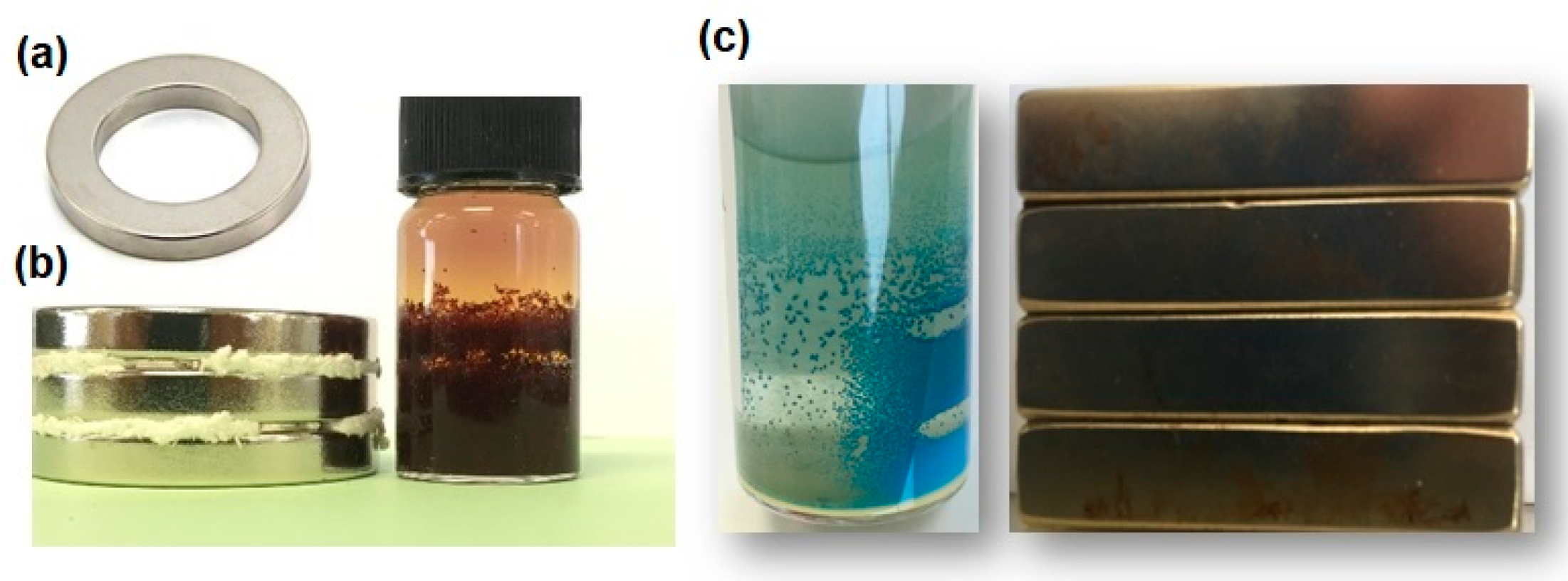
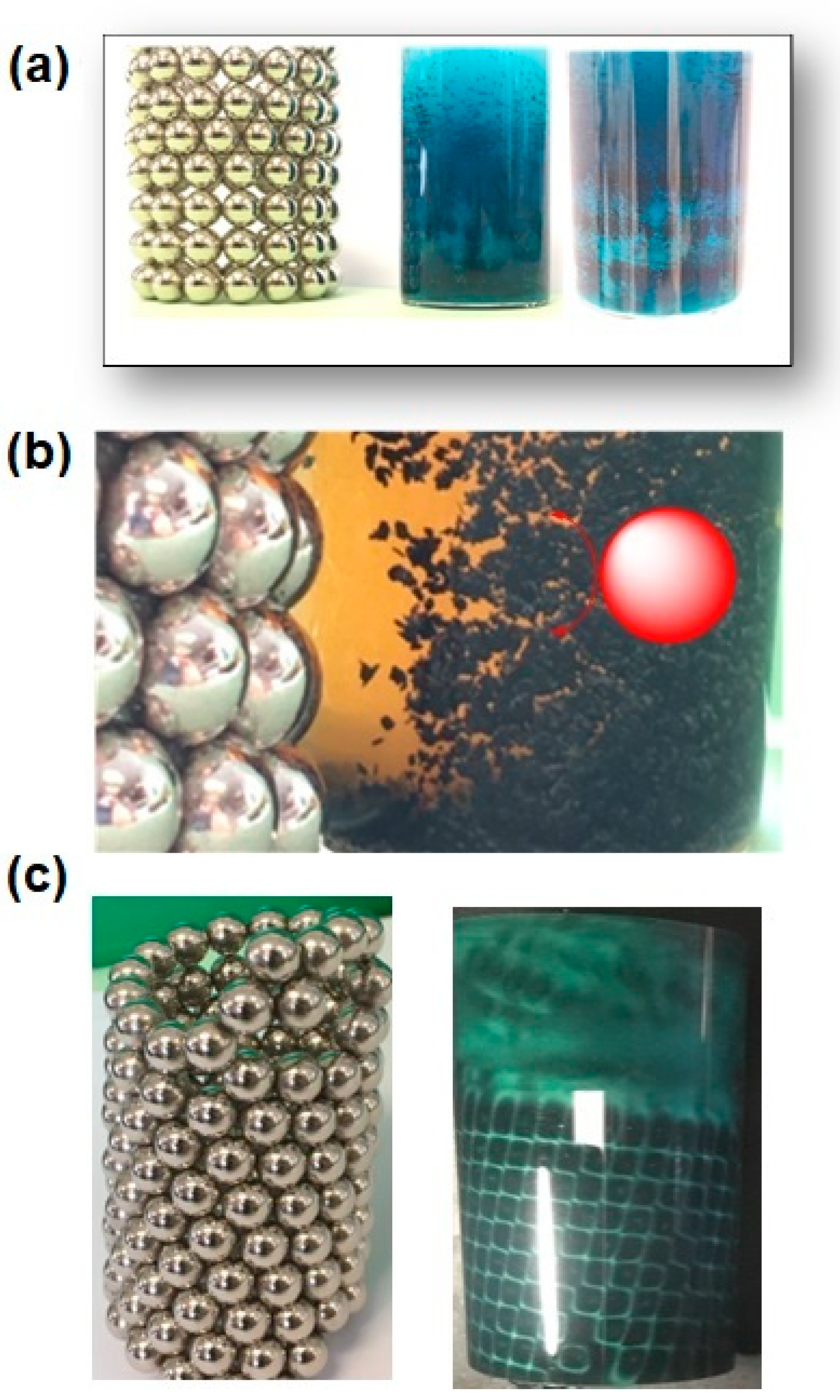
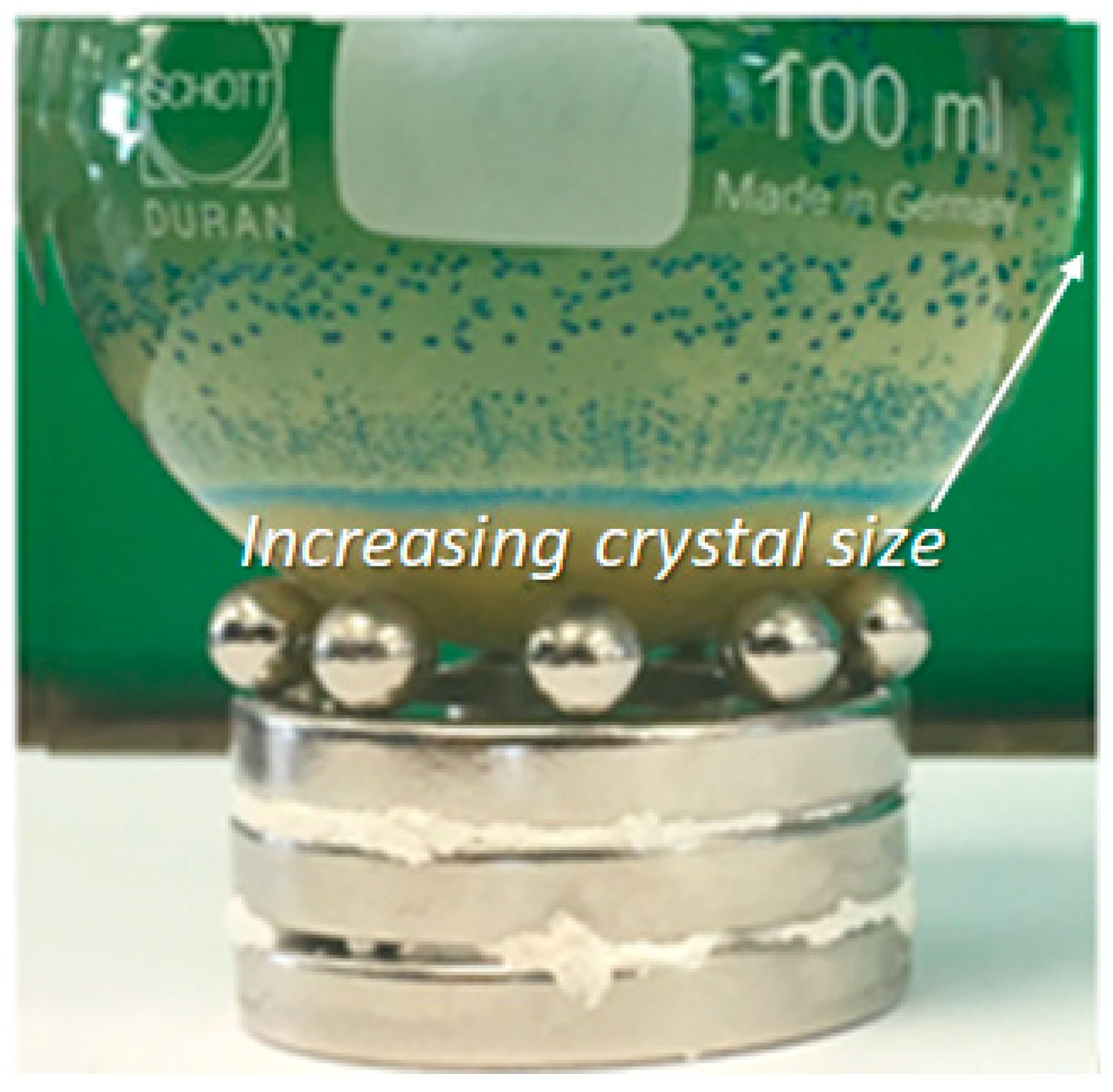

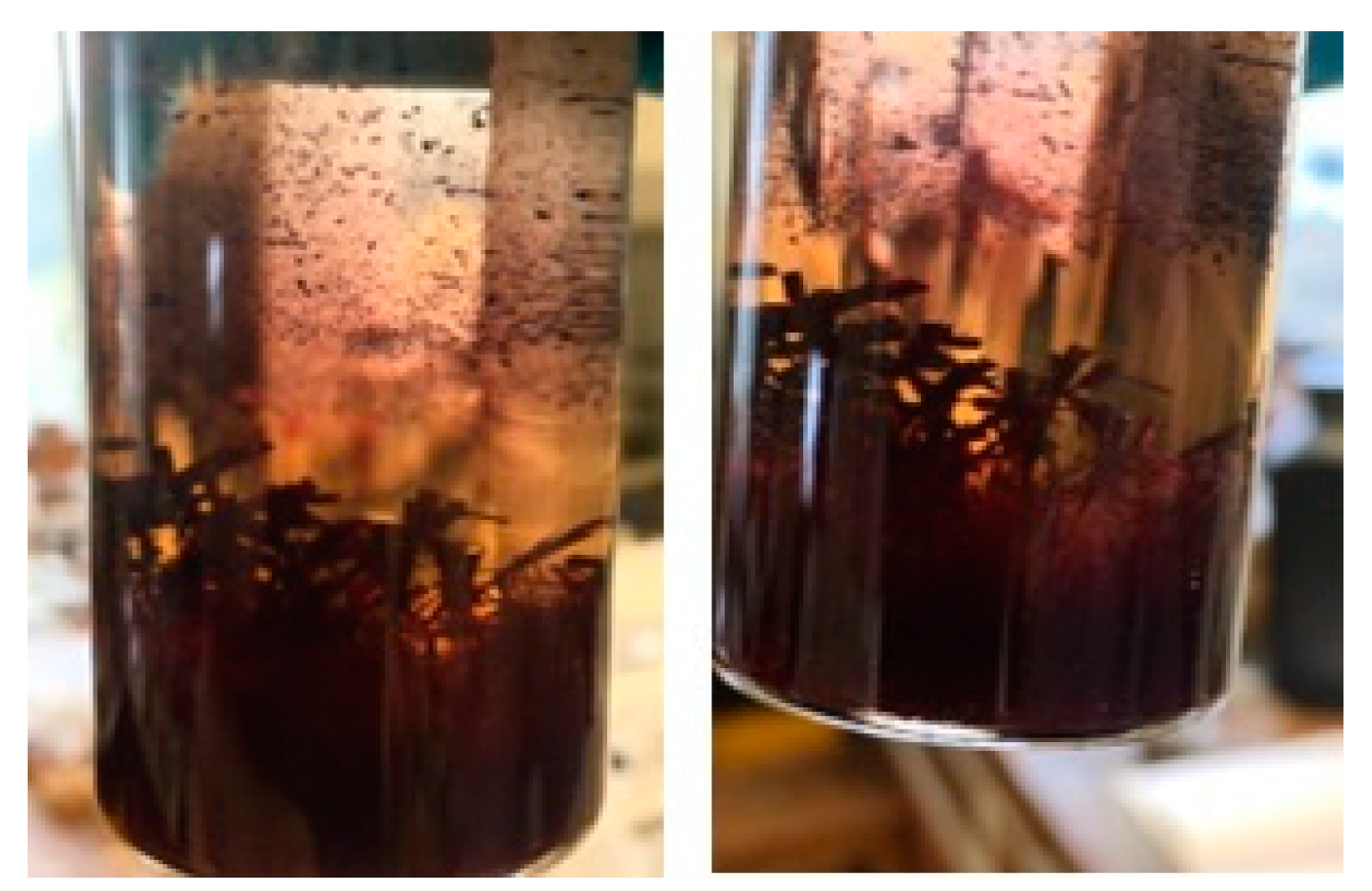
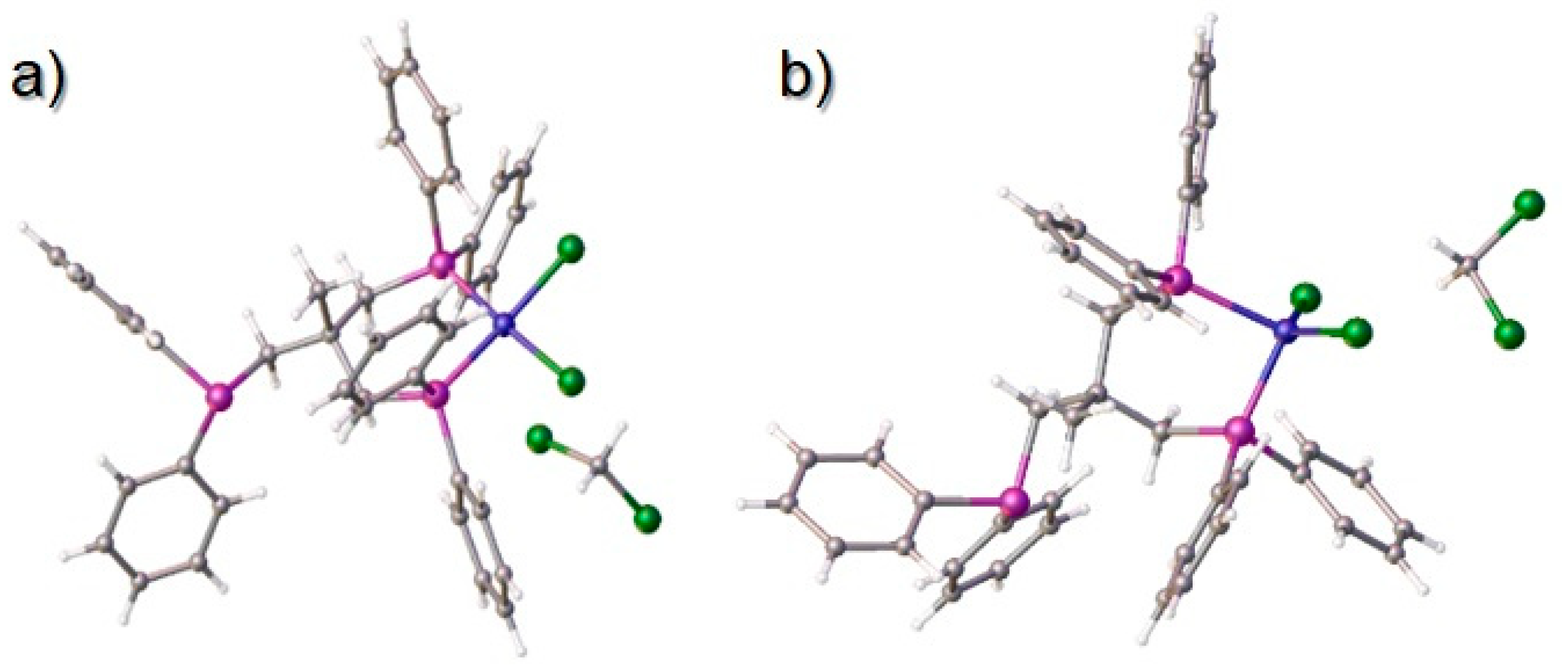
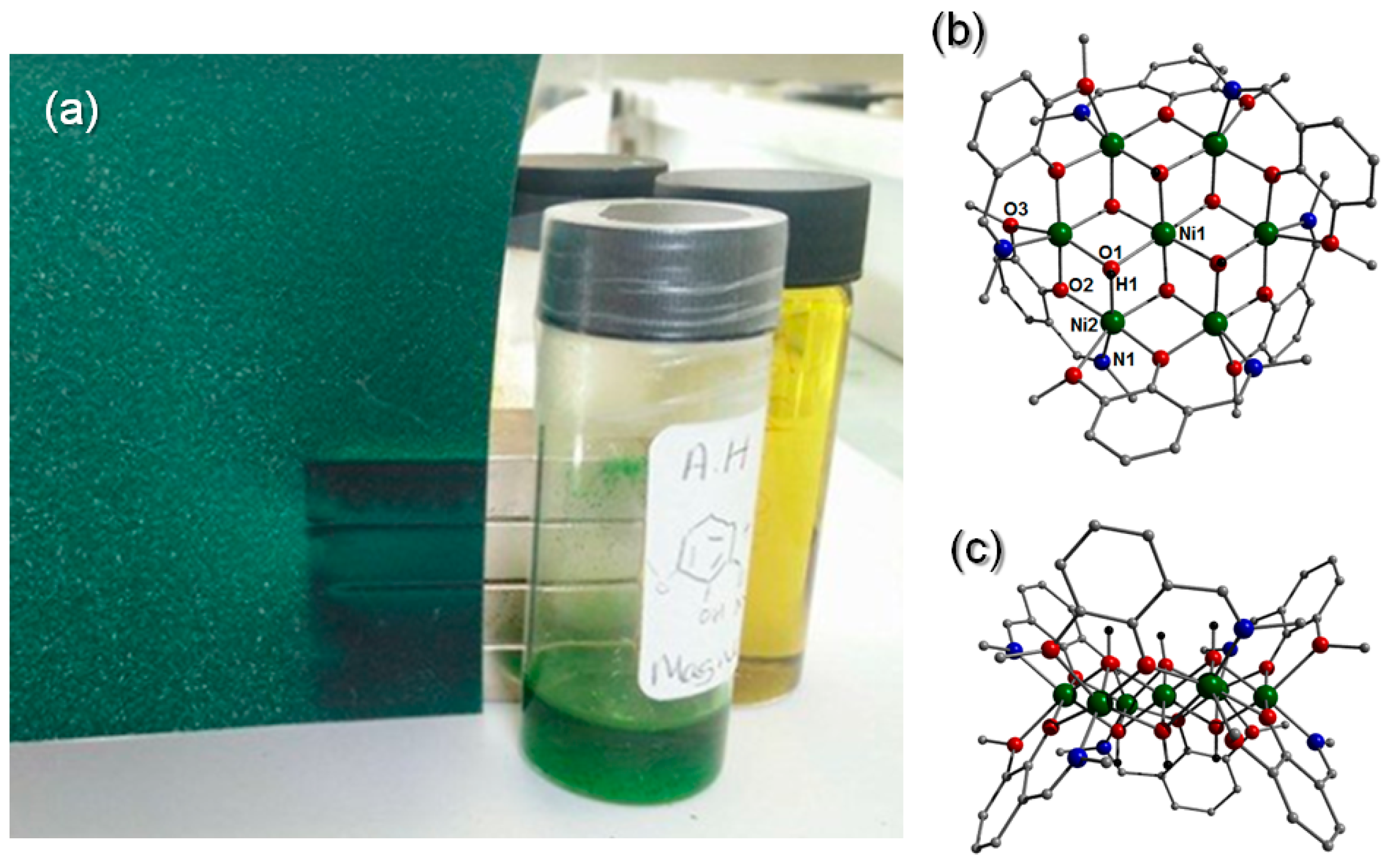
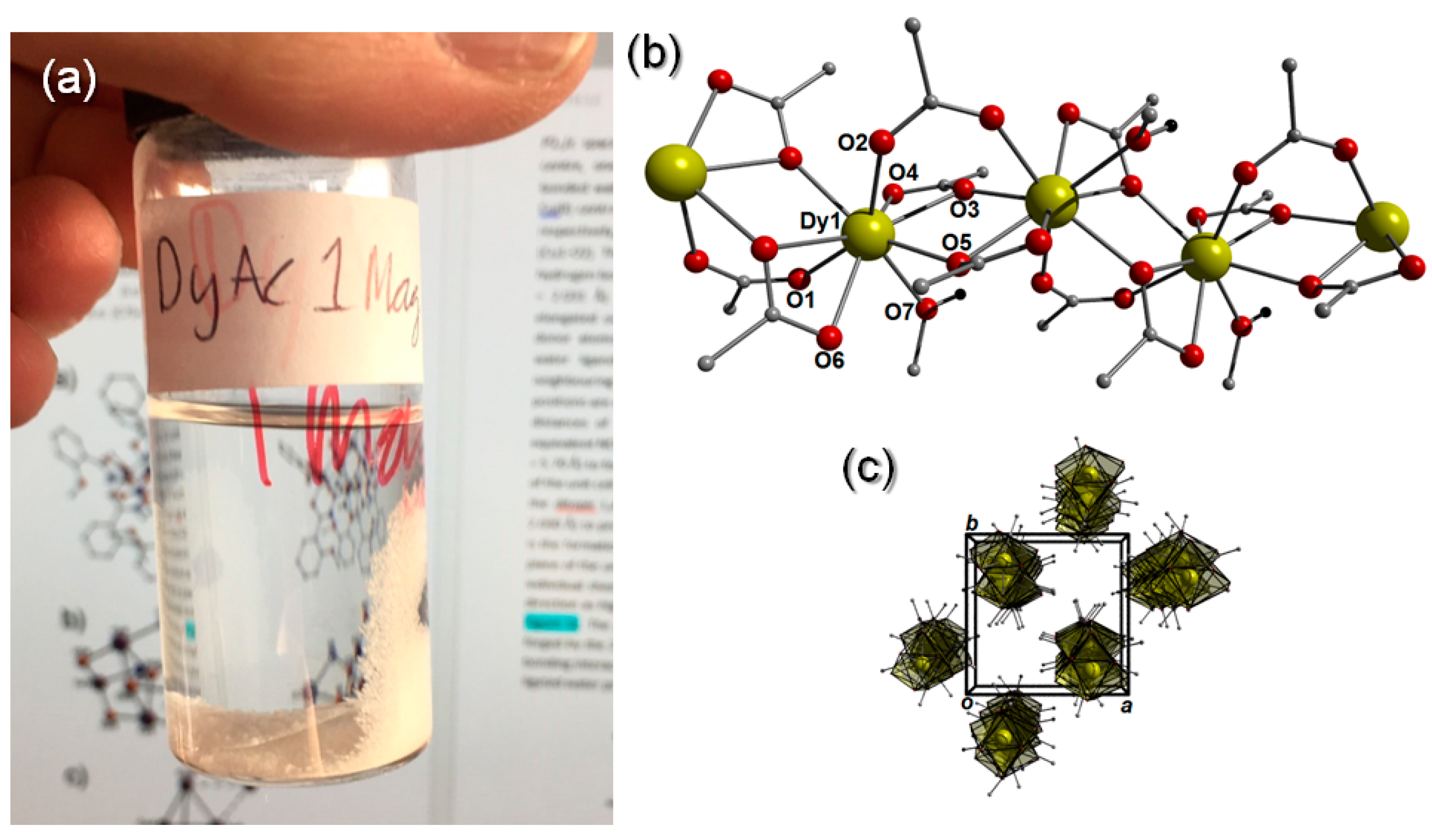
Disclaimer/Publisher’s Note: The statements, opinions and data contained in all publications are solely those of the individual author(s) and contributor(s) and not of MDPI and/or the editor(s). MDPI and/or the editor(s) disclaim responsibility for any injury to people or property resulting from any ideas, methods, instructions or products referred to in the content. |
© 2025 by the authors. Licensee MDPI, Basel, Switzerland. This article is an open access article distributed under the terms and conditions of the Creative Commons Attribution (CC BY) license (https://creativecommons.org/licenses/by/4.0/).
Share and Cite
Butler, I.R.; Williams, R.M.; Heeroma, A.; Horton, P.N.; Coles, S.J.; Jones, L.F. The Effect of Localized Magnetic Fields on the Spatially Controlled Crystallization of Transition Metal Complexes. Inorganics 2025, 13, 117. https://doi.org/10.3390/inorganics13040117
Butler IR, Williams RM, Heeroma A, Horton PN, Coles SJ, Jones LF. The Effect of Localized Magnetic Fields on the Spatially Controlled Crystallization of Transition Metal Complexes. Inorganics. 2025; 13(4):117. https://doi.org/10.3390/inorganics13040117
Chicago/Turabian StyleButler, Ian R., Rhodri M. Williams, Alice Heeroma, Peter N. Horton, Simon J. Coles, and Leigh F. Jones. 2025. "The Effect of Localized Magnetic Fields on the Spatially Controlled Crystallization of Transition Metal Complexes" Inorganics 13, no. 4: 117. https://doi.org/10.3390/inorganics13040117
APA StyleButler, I. R., Williams, R. M., Heeroma, A., Horton, P. N., Coles, S. J., & Jones, L. F. (2025). The Effect of Localized Magnetic Fields on the Spatially Controlled Crystallization of Transition Metal Complexes. Inorganics, 13(4), 117. https://doi.org/10.3390/inorganics13040117







